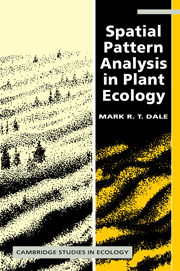Book contents
- Frontmatter
- Contents
- Preface
- 1 Concepts of spatial pattern
- 2 Sampling
- 3 Basic methods for one dimension and one species
- 4 Spatial pattern of two species
- 5 Multispecies pattern
- 6 Two-dimensional analysis of spatial pattern
- 7 Point patterns
- 8 Pattern on an environmental gradient
- 9 Conclusions and future directions
- Bibliography
- Glossary of abbreviations
- List of plant species
- Index
4 - Spatial pattern of two species
Published online by Cambridge University Press: 04 December 2009
- Frontmatter
- Contents
- Preface
- 1 Concepts of spatial pattern
- 2 Sampling
- 3 Basic methods for one dimension and one species
- 4 Spatial pattern of two species
- 5 Multispecies pattern
- 6 Two-dimensional analysis of spatial pattern
- 7 Point patterns
- 8 Pattern on an environmental gradient
- 9 Conclusions and future directions
- Bibliography
- Glossary of abbreviations
- List of plant species
- Index
Summary
Introduction
Vegetation is patchy at a range of spatial and temporal scales, and so even within what might be recognized as a single plant community, the plants of different species are not really expected to be arranged homogeneously and independently. Natural groupings of species may arise from biological interactions or from shared and divergent responses to abiotic factors. In some cases, the community is viewed as a mosaic of patches, with each phase of the mosaic being characterized by a set of species' abundances. This phenomenon in plant communities has given rise to the patch dynamics approach to studies of vegetation (van der Maarel 1996).
The existence of nonrandomness in species arrangement is the context in which the multivariate analysis method of classification takes place. Classification can be used to organize samples, like quadrats, into hierarchical categories based on the similarity of species composition. The composition and strength of the associations within and between groupings is an important aspect of the plant community's structure. It is reasonable to begin to investigate this structure by examining the relationships of pairs of species because these pairwise interactions can then be amalgamated loosely or exclusively into larger groupings. We will therefore examine methods designed to evaluate the joint spatial pattern of pairs of species and thus the scales at which they are positively or negatively associated.
When we look at the spatial pattern of a single species, we are examining the arrangement in space of two mosaic phases, places where the species is present (perhaps at variable density) and places where the species is absent.
Information
- Type
- Chapter
- Information
- Spatial Pattern Analysis in Plant Ecology , pp. 100 - 124Publisher: Cambridge University PressPrint publication year: 1999
